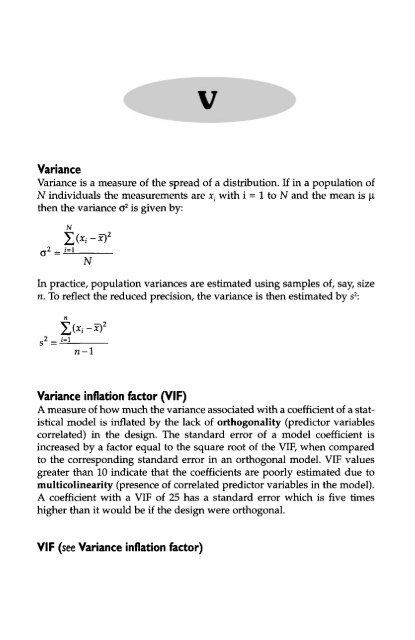- Page 2 and 3:
Dictionary of Evidence-based Medici
- Page 4 and 5:
Preface This book was conceived at
- Page 6 and 7:
A Ability to pay Ability to pay is
- Page 8 and 9:
Dictionary of Evidence-based Medici
- Page 10 and 11:
Dictionary of Evidence-based Medici
- Page 12 and 13:
Figure I Audit: Clinical audit cycl
- Page 14 and 15:
B Balanced design In an experiment,
- Page 16 and 17:
Dictionary of Evidence-based Medici
- Page 18 and 19:
Dictionary of Evidence-based Medici
- Page 20 and 21:
Dictionary of Evidence-based Medici
- Page 22 and 23:
Dictionary of Evidence-based Medici
- Page 24 and 25:
Dictionary of Evidence-based Medici
- Page 26 and 27:
Dictionary of Evidence-based Medici
- Page 28 and 29:
Dictionary of Evidence-based Medici
- Page 30 and 31:
Dictionary of Evidence-based Medici
- Page 32 and 33:
Dictionary of Evidence-based Medici
- Page 34 and 35:
Dictionary of Evidence-based Medici
- Page 36 and 37:
Dictionary of Evidence-based Medici
- Page 38 and 39:
Dictionary of Evidence-based Medici
- Page 40 and 41:
Dictionary of Evidence-based Medici
- Page 42 and 43:
Dictionary of Evidence-based Medici
- Page 44 and 45:
Dictionary of Evidence-based Medici
- Page 46 and 47:
Dictionary of Evidence-based Medici
- Page 48 and 49:
Dictionary of Evidence-based Medici
- Page 50 and 51:
Dictionary of Evidence-based Medici
- Page 52 and 53:
Dictionary of Evidence-based Medici
- Page 54 and 55:
Dictionary of Evidence-based Medici
- Page 56 and 57:
Dictionary of Evidence-based Medici
- Page 58 and 59:
Dictionary of Evidence-based Medici
- Page 60 and 61:
Dictionary of Evidence-based Medici
- Page 62 and 63:
Dictionary of Evidence-based Medici
- Page 64 and 65:
Dictionary of Evidence-based Medici
- Page 66 and 67:
Figure 9 Concept of externality Dic
- Page 68 and 69:
Dictionary of Evidence-based Medici
- Page 70 and 71:
Dictionary of Evidence-based Medici
- Page 72 and 73:
G Game theory Game theory, first de
- Page 74 and 75:
Dictionary of Evidence-based Medici
- Page 76 and 77:
Dictionary of Evidence-based Medici
- Page 78 and 79:
Dictionary of Evidence-based Medici
- Page 80 and 81:
Dictionary of Evidence-based Medici
- Page 82 and 83:
Dictionary of Evidence-based Medici
- Page 84 and 85:
Dictionary of Evidence-based Medici
- Page 86 and 87:
I ICD (see International Classifica
- Page 88 and 89:
Dictionary of Evidence-based Medici
- Page 90 and 91:
Dictionary of Evidence-based Medici
- Page 92 and 93:
Dictionary of Evidence-based Medici
- Page 94 and 95:
K Keynes, John Maynard (1883-1946)
- Page 96 and 97:
Dictionary of Evidence-based Medici
- Page 98 and 99:
Dictionary of Evidence-based Medici
- Page 100 and 101:
M Macroeconomics Macroeconomics is
- Page 102 and 103:
Dictionary of Evidence-based Medici
- Page 104 and 105:
Dictionary of Evidence-based Medici
- Page 106 and 107:
Dictionary of Evidence-based Medici
- Page 108 and 109:
Dictionary of Evidence-based Medici
- Page 110 and 111:
Dictionary of Evidence-based Medici
- Page 112 and 113:
N N of I trial An N of 1 trial is a
- Page 114 and 115:
Dictionary of Evidence-based Medici
- Page 116 and 117: o OBM (see Opinion-based medicine)
- Page 118 and 119: Dictionary of Evidence-based Medici
- Page 120 and 121: Dictionary of Evidence-based Medici
- Page 122 and 123: Dictionary of Evidence-based Medici
- Page 124 and 125: Dictionary of Evidence-based Medici
- Page 126 and 127: Dictionary of Evidence-based Medici
- Page 128 and 129: Dictionary of Evidence-based Medici
- Page 130 and 131: Dictionary of Evidence-based Medici
- Page 132 and 133: Dictionary of Evidence-based Medici
- Page 134 and 135: Dictionary of Evidence-based Medici
- Page 136 and 137: Dictionary of Evidence-based Medici
- Page 138 and 139: Dictionary of Evidence-based Medici
- Page 140 and 141: Figure 25 Measuring quality of life
- Page 142 and 143: Dictionary of Evidence-based Medici
- Page 144 and 145: Dictionary of Evidence-based Medici
- Page 146 and 147: Dictionary of Evidence-based Medici
- Page 148 and 149: Dictionary of Evidence-based Medici
- Page 150 and 151: S Scarcity Scarcity is often referr
- Page 152 and 153: Dictionary of Evidence-based Medici
- Page 154 and 155: Dictionary of Evidence-based Medici
- Page 156 and 157: Dictionary of Evidence-based Medici
- Page 158 and 159: T TDM (see Therapeutic drug monitor
- Page 160 and 161: Dictionary of Evidence-based Medici
- Page 162 and 163: u Unique value effect This term is
- Page 164 and 165: Dictionary of Evidence-based Medici
- Page 168 and 169: Dictionary of Evidence-based Medici
- Page 170: Z Z variate A random variable which










